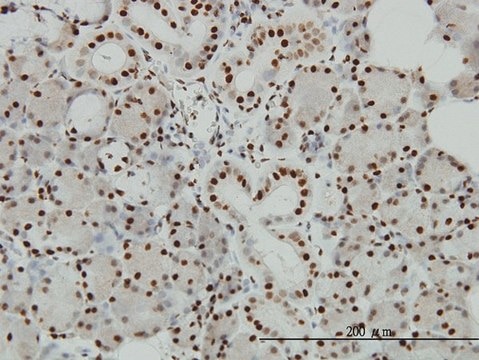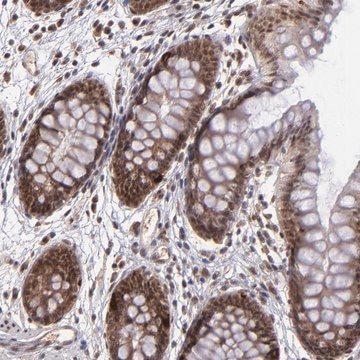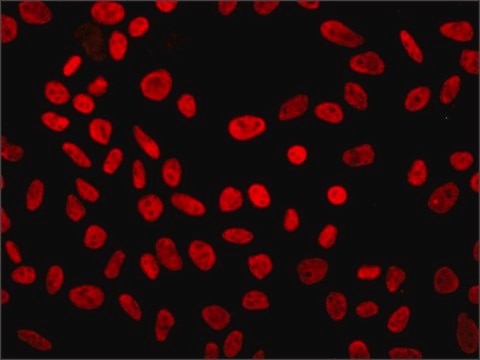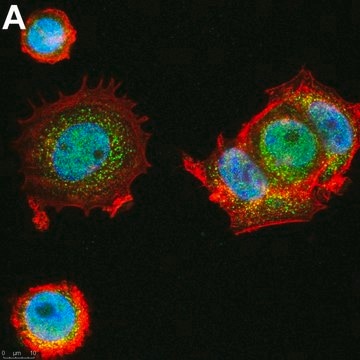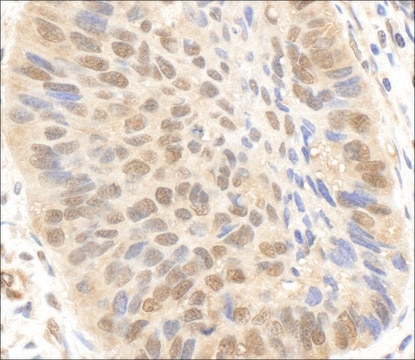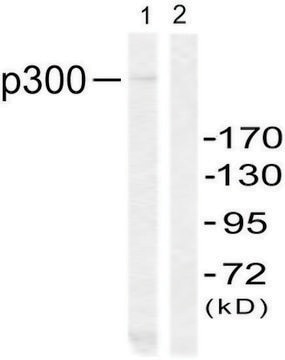SAB1403776
Monoclonal Anti-EP300 antibody produced in mouse
clone 1D2, ascites fluid
Sign Into View Organizational & Contract Pricing
All Photos(2)
About This Item
UNSPSC Code:
12352203
NACRES:
NA.41
Recommended Products
biological source
mouse
Quality Level
conjugate
unconjugated
antibody form
ascites fluid
antibody product type
primary antibodies
clone
1D2, monoclonal
mol wt
antigen ~37.11 kDa
species reactivity
human
technique(s)
indirect ELISA: suitable
western blot: 1:500-1:1000
isotype
IgG1
NCBI accession no.
UniProt accession no.
shipped in
dry ice
storage temp.
−20°C
target post-translational modification
unmodified
Gene Information
human ... EP300(2033)
General description
This gene encodes the adenovirus E1A-associated cellular p300 transcriptional co-activator protein. It functions as histone acetyltransferase that regulates transcription via chromatin remodeling and is important in the processes of cell proliferation and differentiation. It mediates cAMP-gene regulation by binding specifically to phosphorylated CREB protein. This gene has also been identified as a co-activator of HIF1A (hypoxia-inducible factor 1 alpha), and thus plays a role in the stimulation of hypoxia-induced genes such as VEGF. Defects in this gene are a cause of Rubinstein-Taybi syndrome and may also play a role in epithelial cancer. (provided by RefSeq)
Immunogen
EP300 (NP_001420, 731 a.a. ~ 830 a.a) partial recombinant protein with GST tag. MW of the GST tag alone is 26 KDa.
Sequence
PPLQHHGQLAQPGALNPPMGYGPRMQQPSNQGQFLPQTQFPSQGMNVTNIPLAPSSGQAPVSQAQMSSSSCPVNSPIMPPGSQGSHIHCPQLPQPALHQN
Sequence
PPLQHHGQLAQPGALNPPMGYGPRMQQPSNQGQFLPQTQFPSQGMNVTNIPLAPSSGQAPVSQAQMSSSSCPVNSPIMPPGSQGSHIHCPQLPQPALHQN
Biochem/physiol Actions
E1A binding protein p300 (p300) and CBP (CREB binding protein) are highly related transcriptional coactivators. Both proteins have been identified through protein interaction assays. In addition to interacting with a variety of cellular factors and oncoproteins, loss of the wild type CBP alleles in isolated tumors suggests that CBP/p300 might serve as tumor suppressors. The ability of p300 to acetylate many transcription factors, including tumor suppressor p53, E2 factor (E2F), transcription factors II E and -F (TFIIE and -F) etc. demonstrates a novel mechanism of targeted p300 regulation of gene expression. Mutations in the gene encoding the protein have been linked to Rubinstein-Taybi syndrome (RSTS).
Physical form
Clear solution
Not finding the right product?
Try our Product Selector Tool.
recommended
Product No.
Description
Pricing
wgk_germany
WGK 1
flash_point_f
Not applicable
flash_point_c
Not applicable
Certificates of Analysis (COA)
Search for Certificates of Analysis (COA) by entering the products Lot/Batch Number. Lot and Batch Numbers can be found on a product’s label following the words ‘Lot’ or ‘Batch’.
Already Own This Product?
Find documentation for the products that you have recently purchased in the Document Library.
Expanding the phenotypic spectrum in EP300-related Rubinstein-Taybi syndrome.
Solomon BD
American Journal of Medical Genetics. Part A, 167A(5), 1111-1116 (2015)
Molecular cloning and functional analysis of the adenovirus E1A-associated 300-kD protein (p300) reveals a protein with properties of a transcriptional adaptor.
Eckner R
Genes & Development, 8(8), 869-884 (1994)
Jihong Chen et al.
Scientific reports, 5, 13727-13727 (2015-09-12)
Skeletal myogenesis is a highly ordered process which specifically depends on the function of transcriptional coactivator p300. Previous studies have established that Akt/protein kinase B (PKB), a positive regulator of p300 in proliferating cells, is also important for proper skeletal
Robin P Smith et al.
PLoS genetics, 10(10), e1004648-e1004648 (2014-10-03)
Inter-individual variation in gene regulatory elements is hypothesized to play a causative role in adverse drug reactions and reduced drug activity. However, relatively little is known about the location and function of drug-dependent elements. To uncover drug-associated elements in a
Our team of scientists has experience in all areas of research including Life Science, Material Science, Chemical Synthesis, Chromatography, Analytical and many others.
Contact Technical Service